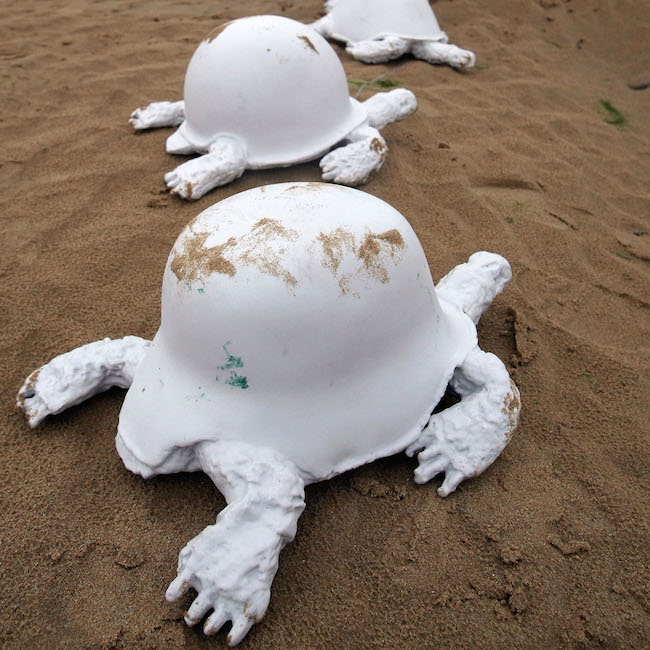We’re kicking off our weeklong tribute to white in contemporary ceramic art with a work that’s not quite contemporary and not quite ceramic art. But the project— in its scope, concept and execution— can certainly hang against the other things we have planned for this week. In 2011, French painter and sculptor Rachid Khimoune loosed an army of sea turtles on his home country.
Above image: Rachid Khimoune, Peace Turtles, 2011 (AP Photo/Vincent Michel)
Rachid Khimoune: Peace Turtles were deployed in locations across France as a memorial for D-Day. One thousand turtles symbolizing the atrocities of war were created by the artist who cast them in resin from old war helmets he found in antique stores and thrift shops. He arranged these in places such as Omaha Beach, the site of one of the decisive battles of World War II.
“The turtle is the symbol of wisdom and humanity: It hibernates most of the year and comes out during the spring,” the artist states. “The cycle sadly depicts the recurring suffering linked to the War.”


Khimoune deliberately chose helmets from different armies to make his casts. German, Russian and American helmets are all represented in the work. By doing this Khimoune gives us a different kind of war memorial, one that is divorced from nationalism. We’ve written about this idea before in our piece about the ceramic poppies surrounding the tower of London. The narratives of most war memorials are of a type. Typical war memorials are dedicated to soldiers. While we respect that, we also suspect that in glorifying the soldier, these memorials forget the human being who wore the uniform. They ignore the plans this human being had before the war started. They ignore the family he or she left behind. They ignore the possibility that the person wearing the uniform may have opposed the war, indeed, that he may have been coerced into fighting by callous, indifferent and inhumane forces larger than himself. By ignoring this thread, typical war memorials read like monuments to the military power of the state. These soldiers sacrificed themselves, these memorials say, as we all must if the state demands it of us.
In this way the cycle repeats itself, millions of men, women and children dying horribly because of the failings of their governments. Memorials like Khimoune’s show us the other side of the coin. It’s a simple wish for a better world and while people may sneer at that sentiment, it’s precisely what they need to be reminded of over and over and over again.
It’s a thorny approach, however. It’s hard to imagine a more “just” war than the one that rid the world of Hitler and the Nazis. There’s also the issue of being sensitive to people who, unlike myself, actually had to pick up a gun and fight. We came across one letter from a vetran who was offended by the installation. He writes:
“As a veteran, I was appalled at the insensitivity displayed by the ‘artist.’ His knowledge of the facts also leaves something to be desired. There were no British or Canadian helmets shown, although these countries lost many men in this operation. Secondly, no Russian troops took part in Operation Overlord.”
My gut reaction was to get defensive, but I think it’s more important to not put my own rhetoric above people’s actual experience. Instead, let me say that I believe these sculptures were crafted in complete empathy for the people who had to wear those helmets. The sculptures do not carry a message of condemnation against soldiers themselves. In fact, I think Khimoune goes out of his way to avoid that. Turtles are (mostly) peaceful creatures; their helmet shells are there only to protect them from the bloody designs of predators. Khimoune’s choice of white is another sign. The turtles maintain their purity even though they’re being thrown into the jaws of death. They are not stained by their experience. Their essential nature does not change. They only march forward, waiting for a day when they will be safe. If there’s guilt, it rests with the people who deny them that day.

Khimoune, according to his biography, was born from Kabyle parents at Decazeville, France in 1953. He graduated from the School of Art, Paris in 1974. After moving on from painting into sculpture, he won the Foundation of France prize in 1980. He’s exhibited since 1975, with works appearing in New York City, Paris, Shanghai, Dubai, Mexico City and Seoul.
Bill Rodgers is the Managing Editor of cfile.daily.
What do you think of “Rachid Khimoune: Peace Turtles?” Let us know in the comments.



Rachid Khimoune, Peace Turtles, 2011. Photographs courtesy of the artist and Beach Combing Magpie.



What a waste of helmets. Some of those are original german helmets that could be worth tons of money.
Really like this work, and the way CFile steps away from its core every now and then.